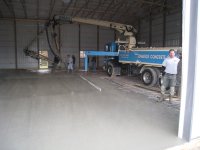terry.dinerman
Gold Member
- Joined
- Oct 11, 2009
- Messages
- 431
- Tractor
- 1990 - JD 870
Sorry, please explain with references. I'm no "professional", but I've been involved with over 2500 yards at my home as I mentioned as well as 10,000 yards or so working other jobs. In 20 years I've never heard anyone say what you said. I'd like to see clear and quantitative information to back up what you claim.
To achieve its design strength, a concrete mix must be uniform throughout.
Excessive vibration will cause the mix to segregate, with the large aggregate sinking to the bottom of the pour...
In a slab, this leads to starving the bottom zone of Portland cement, weakening the area of the slab that is placed under tension when the slab is loaded, as well as creating an aggregate starved and thereby em-brittled zone at the top, which is placed in compression under load...
The use of the correct amount of water to Portland cement normally results in a stiff mix that helps prevent the segregation from taking place but necessitates the use of a vibrator to get it to flow around the reinforcing and into all corners of the form.
Most folks add way too much water to their concrete to get it to flow down the chute for the mix to get even close to the design specs....it is just too danged much work...
The wetter mix is even more susceptible to aggregate segregation during vibration due to this issue and it can even segregate from the force of GRAVITY if dropped from too high above the form...
With all the thousands of yard I've poured, even if a test cylinder was not scheduled to be drawn on any particular job, I was never allowed to accept a truckload that would not pass a slump test.
I turned away a lot of concrete....and the only person I ever saw madder than a concrete truck driver with a refused load was my wife when she found out I broke the tip off her K-Bar opening a paint can...
Anyway - Like all crafts, skills and trades....concrete work ain't just hard labor....there is a lot of "art" in a good end product...
T
